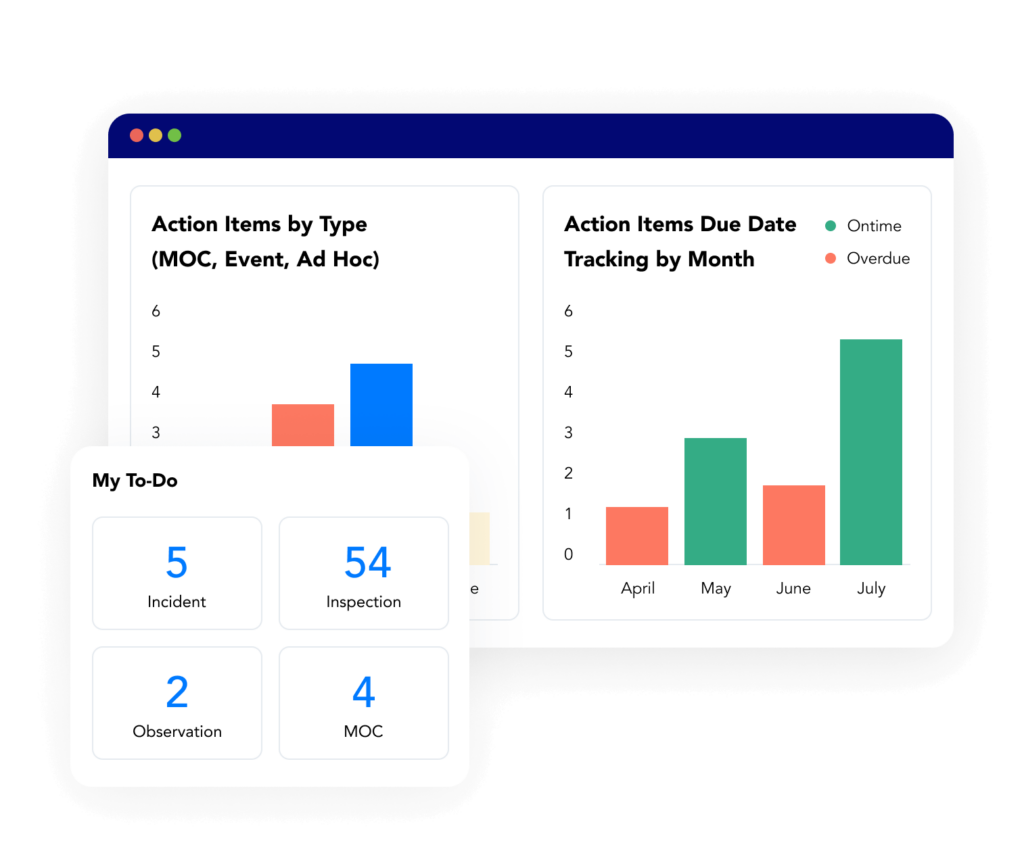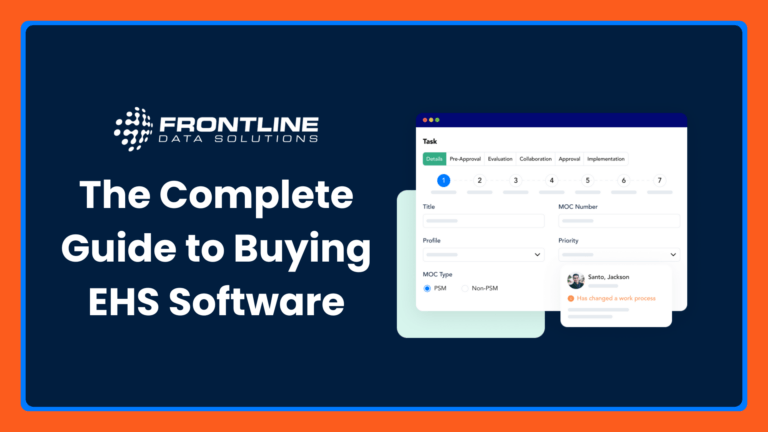How to Select the Best EHS Software
Frontline Data Solutions: Safety Simplified
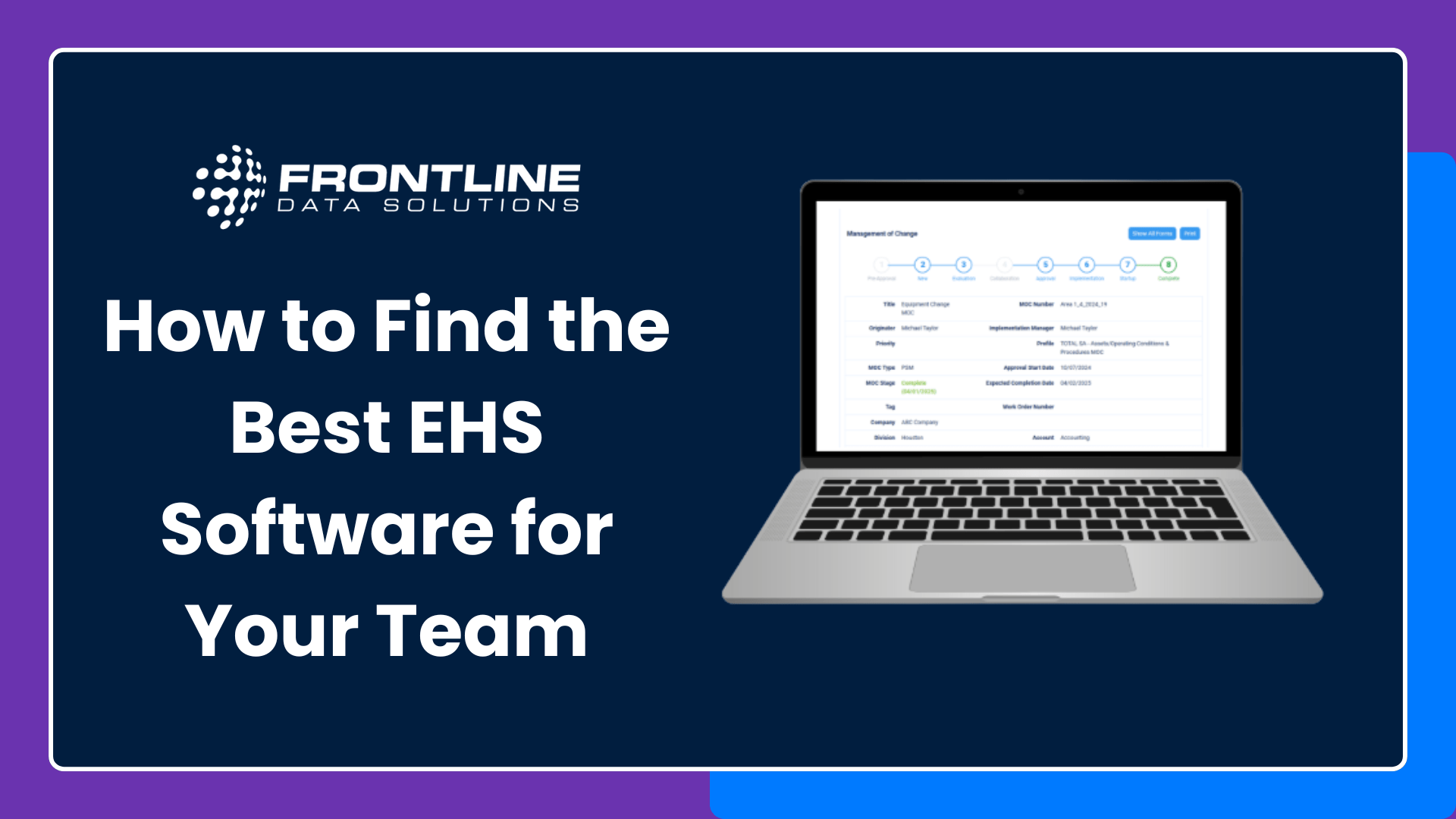
Investing in environmental, health, and safety (EHS) software is a decision that directly impacts your ability to protect workers, maintain compliance, and achieve operational excellence. But with hundreds of providers, how do you know what’s the best EHS software for your team?
Unsurprisingly, it’s more than just a list of features or which pricing tiers are available. In health and safety, the best solutions are those that align with your processes, support your compliance needs, and simplify your team’s to-do list. It’s about usability, flexibility, scalability, and support.
Whether you’re upgrading from a manual process or replacing your current software, there’s a lot to consider. As you evaluate providers, keep these considerations in mind to find the best EHS software for your company.
Chapter 1: Common Mistakes During EHS Software Selection
EHS software costs thousands of dollars per year. In some cases, it costs hundreds of thousands of dollars. So, it’s important to shop carefully to find the best EHS software for your team. Before you can do that, create a game plan of how you’re going to assess different vendors.
The top issues you want to avoid with EHS software are:
- Hidden fees
- More features than functionality
- Disconnected tools that complicate processes
- Limited system configurability and flexibility
Hidden Fees
Some EHS software vendors reel you in with low initial costs but add unexpected charges later. They may charge for additional support, system customizations, extra users, etc. This increases the total cost of ownership for the software and delays the returns you see.
To avoid hidden fees, only consider EHS software vendors that have transparent pricing. If they’re avoidant when you ask for pricing, this may be a red flag that you’re going to incur unexpected charges down the road.
More Features Than Functionality
Another mistake you might make is prioritizing features over functionality. Platforms with long lists of features often lack practical usability. This can negatively affect your team’s efficiency and may lower the return you get from your investment.
Prioritize solutions that are built for end users, not just to impress whoever’s buying the product. Make a list of what your team needs to be successful and use it as your north start when evaluating EHS software solutions.
Disconnected Tools That Complicate Processes
If you come across a solution that has lots of tools available, beware of how user-friendly they are. Oftentimes, large EHS software providers will buy tools from different developers that aren’t connected to each other. Long-term, this increases the risk or errors or missed compliance deadlines.
The best HSE software is a unified platform that integrates incident management, training, and compliance into one system. This eliminates redundancy and streamlines your workflows, so you’re not constantly hopping from tool to tool.
Limited Configurability and Flexibility
Some EHS software systems are not very configurable, meaning you have to adapt your processes to fit the technology’s limitations. This can slow down adoption and create compliance gaps that jeopardize your long-term success.
Don’t fixate on price without evaluating scalability. Instead, choose a highly configurable solution that can grow with you. Being able to tailor the software to your existing processes will help you implement the software faster and have better adoption over time.
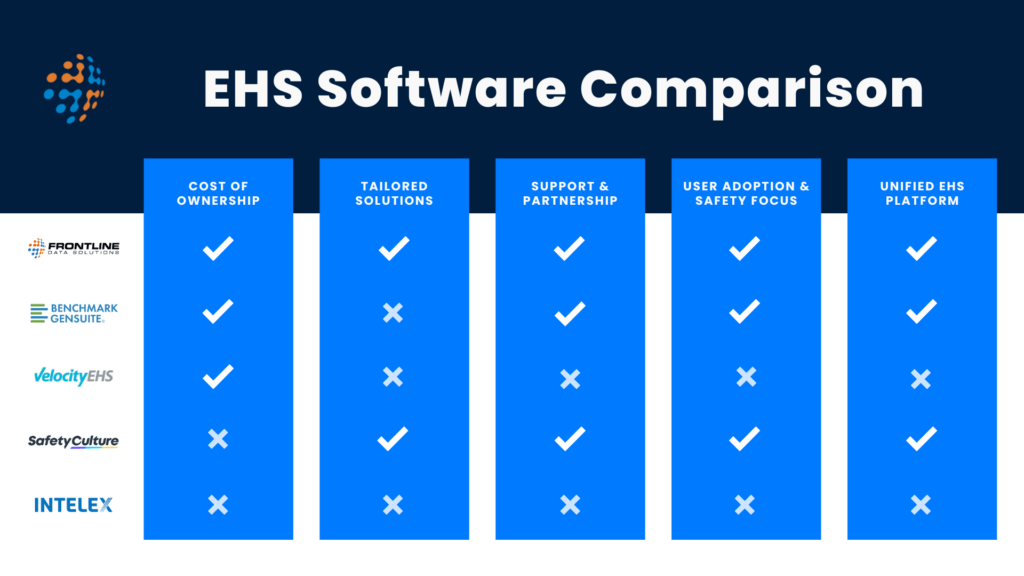
Chapter 2: Best EHS Software Characteristics and Features
When deciding on the best EHS software for your company, look beyond price and specific features. While they’re important factors, they don’t always make for the best long-term investment.
For example, shopping with a very narrow price range might lead you to overlook slightly more expensive systems that are much more scalable for future growth. Or maybe you buy the software with the longest feature list only to find that you don’t need 90% of what you paid for.
In either case, you’re better off evaluating EHS software holistically across several dimensions.
Top HSE software solutions solve real safety challenges, not just back-office tasks. They’re scalable, so you can consistently improve your processes and outcomes. Here are the six characteristics that software should have if you’re going to invest in it.
Lower Total Cost of Ownership (TCO)
One of the first and most critical characteristics is a low total cost of ownership (TCO). Many software platforms appear affordable up front, but have hidden fees, slow deployments, and expensive customizations.
So, while you spend less up front, you spend more in the long run. The most common example of this is customizations for forms and workflows. Most systems have built-in forms that you can use for events like incidents or near misses. But if you want to create your own forms, you have to spend more money for the provider to build them for you.
The best safety software providers like Frontline Data Solutions don’t have these extra charges. They give you the flexibility to create custom forms or reports that align better with your existing processes. That way, you don’t have to spend extra time or money once you’ve implemented the system.
With the right platform, you can scale without spending more on support, training, or duplicate tools. That means fewer delays and more time focused on improving safety performance.
Exceptional Support & Partnership
Equally important is the quality of post-sale support and partnership. After implementation, you might find yourself stuck with unreliable support. This could mean long ticket queues, impersonal service, or rotating support reps who don’t understand your goals.
What you want to look for is a software provider that partners with you to achieve your goals. Their support reps should be responsive and knowledgeable about the system. Of course, it might be hard during a demo to figure out what kind of support you’re getting.
Here are some questions you can ask about customer support services:
- What are your team’s support hours?
- How do we submit support requests?
- Will we have a dedicated support rep who can help us?
- What is your implementation process?
The best EHS software providers will enable you to resolve issues quickly and implement best practices. In other words, your success is their success.
Tailored Solutions
Another characteristic of the best EHS software is flexibility. A common roadblock teams encounter is frustration with the preset workflows. No one wants to change their entire process just to follow the software’s requirements. So, you end up with a frustrated team that either begrudgingly adapts to the new system or doesn’t adopt it at all. Either way, you lose out on your investment without solving problems to the best of your ability.
Leading EHS software providers like Frontline Data Solutions and SafetyCulture offer tailored solutions that you can adapt to your needs. They include things like:
- Customizable reports
- Configurable workflows
- Flexible user roles and permissions
- Options for custom integrations
Being able to configure the system on your own without support is a game changer. It gives you more control and keeps your team more adaptable. This is especially true if you deal with changing regulations and need to adjust how you collect or report data.

Frontline-First User Adoption
If you’re buying EHS software, then chances are you’re trying to improve safety within your company. To do that, you need software that’s user-friendly. That’s because ease of use can make or break whether you get value from the system.
The first step is to decide whether your workers are ready to adopt new technology. A common mistake is switching systems without considering the impact it has on the team. If your team is ready for a change, the next step is to find a solution that’s simple enough to adopt.
When attending software demos, pay close attention to how the software looks and feels. Try to look at it from the perspective of your frontline workers. Will it be hard for them to navigate? Does the system have mobile capabilities?
To maximize value, you have to prioritize user adoption. The higher your adoption rate, the better visibility you’ll have over what your team’s working on. Plus, you’ll be able to close any reporting gaps and feel more confident in the accuracy of the data. This helps you make better decisions so you can reduce risks.
Dedicated Safety & Compliance Focus
The purpose of EHS software is to simplify safety compliance. That’s why the best EHS software comes from providers who are dedicated and focused on this goal.
You can often tell that a software provider isn’t fully committed to safety when their product lineup is all over the place. Oftentimes, this looks like EHS, HR, ESG, etc., tools smashed under a single brand. This is a red flag because it means that they might be doing a lot of different things poorly and none of them effectively.
The best EHS software is built specifically for safety applications. It will have a small lineup of core products designed for EHS professionals while potentially offering some ad hoc tools.
Another way to discern this is during the buying process. If the salesperson doesn’t seem to be knowledgeable about your EHS needs, then that’s a red flag. You want to buy from a provider that understands safety compliance and can help you figure out the best way to reach your goals.
Try not to get distracted while evaluating different vendors. At the end of the day, you need software that aligns with your EHS program. This will allow you to avoid fines, prevent incidents, streamline processes, and reduce overall risk.
Unified EHS Platform
Finally, the best EHS platforms bring it all together with a unified system. Disconnected tools, often bought from several software developers, aren’t very user-friendly. Oftentimes, they’re not even useful.
You can spot these systems just by looking at them. For example, do all the tools look different? If so, they probably came from different developers. While this isn’t always an issue, it often means the tools don’t work well with each other (if at all).
Instead, find a unified EHS platform like the one from Frontline Data Solutions that brings all your data is a single, easy-to-access location. This consolidation not only improves data accuracy and response time, but it also reduces training burdens, simplifies user access, and empowers you with clear visibility into what’s happening.
How NeoGraf Gained Visibility with Frontline EHS Software
NeoGraf implemented EHS software from Frontline Data Solutions to get full oversight of their EHS program and goals, so they could excel beyond compliance.
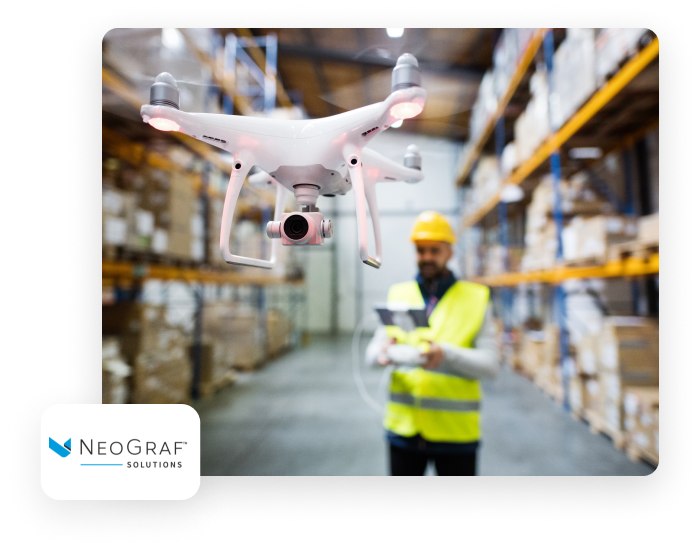
Chapter 3: How to Assess HSE Software Systems
Choosing the best EHS software starts with evaluating the product itself. The goal is to figure out whether it will fit within your existing operations. To do that, you need to spend time reviewing the software during the demo, or better yet, in a sandbox environment.
This is more than just assessing software products. It’s also about setting expectations for what you’re looking to achieve. You might find that none of the options align with your current process. In that case, you’re going to have to make some changes when you implement the software.
Below are the questions you should ask yourself while you’re assessing EHS software.
Configurability: Will It Fit Your Processes?
A highly configurable platform is critical for long-term success. If the software can’t adapt to your existing workflows, you’ll either have to change your process to fit the system or rely on the vendor to make changes. In either case, you spend more time or money than needed to get the software working for your team.
During demos, ask to see how you would build forms, edit workflows, and set user permissions. The best EHS software solutions allow your internal team to manage configurations without help.
User Experience: Will Your Team Actually Use It?
No matter how powerful the software is, if your team can’t figure it out or doesn’t want to use it, the investment won’t pay off. During your software demo, look at the interface through the eyes of frontline workers.
Is it intuitive? Is the mobile version easy to use? Do workflows make sense with minimal training?
High user adoption comes from clean design and simple navigation. Don’t make the mistake of choosing a complicated system that’s hard to adopt.
Unified Platform: Is Everything in One Place?
Some vendors offer multiple tools under one brand, but they’re separate products with different designs, logins, and databases. This creates data silos and increases your risk of errors.
A truly unified EHS platform will connect incident management, training, audits, contractor oversight, and compliance reporting within a single interface. Ask for a demo of cross-functional workflows to verify how connected the system really is.
Chapter 4: How to Evaluate Software Vendors
After assessing the software itself, the next step is to evaluate the vendor behind it. The right provider can make or break your implementation and your long-term success. Focus on these three key areas: cost transparency, quality of support, and depth of EHS expertise.
Cost Transparency: Are There Hidden Fees?
The total cost of ownership is more than just a license fee. Many vendors offer a low starting price but add fees for customizations, extra users, support, and implementation services.
Ask for a full cost breakdown, including implementation, configuration, training, and any recurring costs tied to system changes. If the vendor avoids giving straight answers, it may be a sign of hidden costs to come.
Partnership: Will They Help You Succeed?
Great software is only valuable if it’s backed by great support. Ask how the vendor handles onboarding, support tickets, and ongoing customer success.
Will you have a dedicated rep? What’s their average response time? What kind of training do they provide?
High-quality vendors view support as a partnership and not just a service desk. They’ll work with you to ensure your implementation is successful and your team is set up for success.
Safety Expertise: Do They Understand EHS?
Not all software vendors have a deep understanding of safety management. Some platforms are built for general compliance, HR, or ESG but not for the specific needs of EHS professionals.
During the buying process, ask about audits, corrective actions, incident follow-ups, and compliance reports. Vendors with real EHS experience will be able to show you how their platform supports regulatory alignment and day-to-day safety operations.
Chapter 5: Why Frontline Data Solutions Has the Best EHS Software
At Frontline Data Solutions, we believe that great EHS software doesn’t just check the boxes, it drives real results for the teams who use it every day. That’s why we’ve designed our platform around the core needs of safety professionals, operations managers, and compliance leaders.
Every feature, workflow, and service model we offer reflects a deep understanding of what actually works in the field. Here’s how we bring our differentiators to life — and why that makes all the difference for our customers.
How We Maximize Value for Our Customers
Our mission at Frontline Data Solutions is to simplify safety by providing configurable, user-friendly EHS software. We do that by providing as much value as possible while keeping control in the hands of our customers.
Here are the top ways we maximize value:
- We are always transparent about our pricing and never charge hidden fees.
- We directly implement customer feedback into our product updates and releases.
- We excel during and after implementation to ensure high user adoption rates.
- We offer dedicated account support to respond to tickets and questions faster.
- We follow a train-the-trainer approach to empower customer independence.
- We focus on a core product line to consistently improve functionality.
Overall, we maximize value by giving your team all the tools, knowledge, and support you need to grow and succeed with our system long-term. Ours is the best EHS software on the market because it’s the software that fits to your needs, not the other way around.
Why Our Support is Better Than Our Competitors’
At Frontline Data Solutions, we pride ourselves on going beyond basic support to provide true partnership to all our customers. Our goal is to give you the best experience possible, so you always get value from our products.
We also don’t outsource our support to third parties. Keeping support in-house ensures that our customers get knowledgeable reps who understand the product and their team’s specific needs. This means that we’re able to build meaningful partnerships with customers. Long-term, this translates to higher user adoption, better ticket turnaround time, and fewer headaches.
How Our Software is More Configurability
What truly makes Frontline the best EHS software is how configurable it is. Many of our competitors charge high fees for any sort of changes to the out-of-the-box workflows and forms. So, you’re either stuck with what they offer, or you have to spend more. At Frontline, we’ve designed our workflows to provide structure without limiting what you can do.
For example, using the Events tool in our incident management system, you can create workflows for different types of incidents. Some of the most popular events our customers track with the tool include:
- Injuries
- Near misses
- Safety audits
- Employee onboarding
- Quality inspections
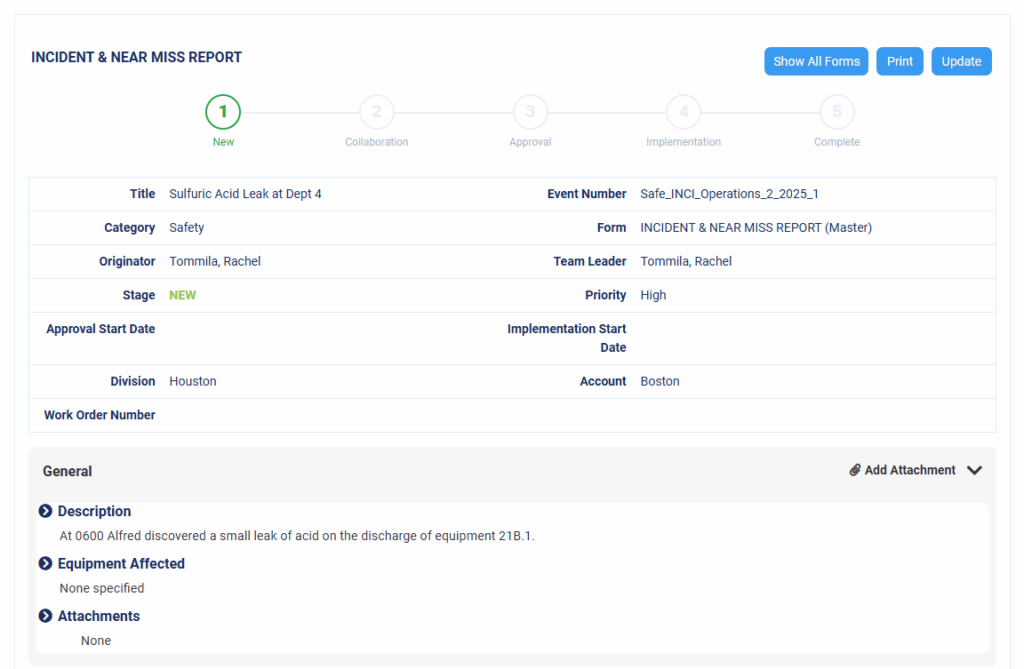
Or using the workflows in our change management software, you can use optional stages depending on the risk of the change. This means you can tailor your documentation to meet different regulatory requirements.
With the configurability of Frontline Data Solutions EHS software, you can replace multiple tools from our competitors with a single system.
Chapter 6: Start the EHS Software Buying Process
By now, you understand what to look for in an EHS software system and how to evaluate vendors that align with your needs. The next step is to put that knowledge into action.
Attending software demos is the best way to see how each solution functions in real-world scenarios and to assess whether it truly fits your team’s workflows, goals, and expectations.
But don’t go into demos blindly. Prepare with a clear sense of your priorities and success criteria, so you can make the most of each conversation and comparison.
Here are some things you can do to prepare ahead of the buying process:
- Create a list of the non-negotiable features or capabilities you need.
- Write a secondary list of all the other things you’d like to have.
- Do some research and identify the ones you want to schedule demos with.
- Put together a list of questions you’ll ask during each demo to evaluate the different software systems and providers.
Ready to Start the Buying Process?
Check out our EHS Software Buyer’s Guide for the full rundown on what to and what to expect.
Choosing the best EHS software requires you to prioritize solutions that maximize value through transparency, usability, and adaptability.
At Frontline Data Solutions, we’re dedicated to these principles, offering a configurable, user-friendly platform trusted by industries like manufacturing and energy. Explore our solutions and see how we can help you avoid the failures of hidden fees, disconnected tools, and limited flexibility.
Want to Take the Next Step?
Book a personalized demo with our team to explore how Frontline Data Solutions can help you increase visibility, improve compliance, and reduce risk in one intuitive platform.
